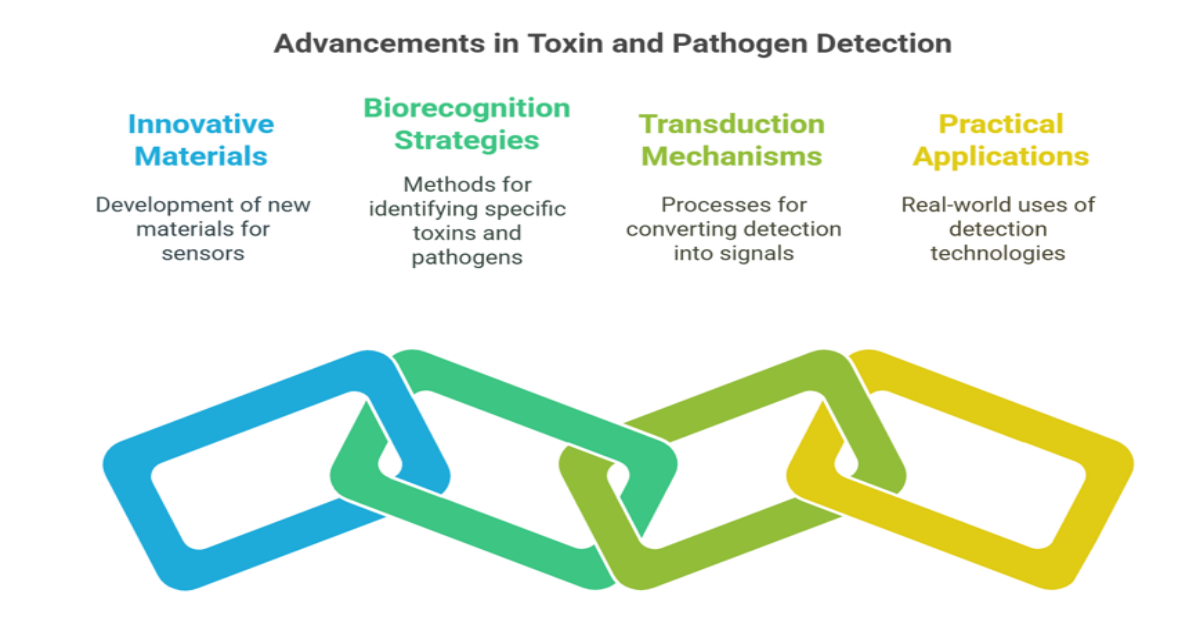Advanced Sensors for Toxin and Pathogen Detection: Innovations, Challenges and Future Perspectives
A special issue of Biosensors (ISSN 2079-6374). This special issue belongs to the section "Biosensors and Healthcare".
Deadline for manuscript submissions: 31 December 2025 | Viewed by 322

Special Issue Editors
Interests: biosensors; nanomaterial-enabled detection; toxin and pathogen sensing; functional nanomaterials; point-of-care diagnostics; active food packaging; photocatalytic degradation; biometric molecular design
Special Issue Information
Dear Colleagues,
The detection of toxins and pathogens is of paramount importance in safeguarding public health, ensuring the safety of food and water, and monitoring environmental contamination. Rapid, sensitive, and selective sensing technologies are urgently needed to address the emerging threats posed by bacterial, viral, and chemical hazards. This Special Issue aims to highlight cutting-edge advancements in the development of sensors for toxin and pathogen detection, covering novel materials, biorecognition strategies, transduction mechanisms, and real-world applications.
We invite original research articles and comprehensive reviews that explore innovative approaches to sensor design, including, but not limited to, those that focus on the following areas:
- Nanomaterial-enhanced (bio)sensors for ultrasensitive detection;
- Optical, electrochemical, and piezoelectric biosensors for toxins and pathogens;
- Lab-on-a-chip and point-of-care devices for field-deployable diagnostics;
- CRISPR-based, aptamer, and immunoassay-integrated sensors;
- Machine learning and AI-driven sensor data analysis;
- Challenges in real-sample analysis (e.g., food matrices, clinical specimens, environmental samples);
- Commercialization and scalability of detection platforms.
Key questions to consider:
- What are the latest breakthroughs in bioreceptor designs (e.g., antibodies, aptamers, enzymes) for toxin/pathogen recognition?
- How can the sensitivity, specificity, and multiplexing capabilities of sensors be improved?
- What are the critical hurdles in transitioning lab-developed sensors to field applications?
- How do emerging technologies (e.g., wearable sensors, microfluidics) reshape detection paradigms?
- What societal demands (e.g., affordability, rapidity) must next-generation sensors fulfill?
We encourage the submission of papers that address these challenges and showcase transformative solutions. Your research will contribute to a multidisciplinary discussion on advancing detection technologies for global health security.
Dr. Qi Sun
Dr. Qingqing Yang
Guest Editors
Manuscript Submission Information
Manuscripts should be submitted online at www.mdpi.com by registering and logging in to this website. Once you are registered, click here to go to the submission form. Manuscripts can be submitted until the deadline. All submissions that pass pre-check are peer-reviewed. Accepted papers will be published continuously in the journal (as soon as accepted) and will be listed together on the special issue website. Research articles, review articles as well as short communications are invited. For planned papers, a title and short abstract (about 250 words) can be sent to the Editorial Office for assessment.
Submitted manuscripts should not have been published previously, nor be under consideration for publication elsewhere (except conference proceedings papers). All manuscripts are thoroughly refereed through a single-blind peer-review process. A guide for authors and other relevant information for submission of manuscripts is available on the Instructions for Authors page. Biosensors is an international peer-reviewed open access monthly journal published by MDPI.
Please visit the Instructions for Authors page before submitting a manuscript. The Article Processing Charge (APC) for publication in this open access journal is 2200 CHF (Swiss Francs). Submitted papers should be well formatted and use good English. Authors may use MDPI's English editing service prior to publication or during author revisions.
Keywords
- biosensors
- toxin detection
- pathogen detection
- nanomaterials
- antibody
- aptamers
- food safety
- environmental monitoring
- AI in sensing
- point-of-care testing (POCT)
Benefits of Publishing in a Special Issue
- Ease of navigation: Grouping papers by topic helps scholars navigate broad scope journals more efficiently.
- Greater discoverability: Special Issues support the reach and impact of scientific research. Articles in Special Issues are more discoverable and cited more frequently.
- Expansion of research network: Special Issues facilitate connections among authors, fostering scientific collaborations.
- External promotion: Articles in Special Issues are often promoted through the journal's social media, increasing their visibility.
- Reprint: MDPI Books provides the opportunity to republish successful Special Issues in book format, both online and in print.
Further information on MDPI's Special Issue policies can be found here.







